How to find... - Tuesday 18 February 2025
Find job opportunities with GlobalData Explorer

GlobalData Explorer (GDX) is a powerful set of databases containing information on markets, companies, countries and products. You can use it in two ways: either by typing keywords into the search bar on the home page to find different types of information on a subject, or by selecting a particular database to find a specific type of information. We will develop this second method below in order to find job offers.
To find job offers abroad in a specific sector, you can quickly access a detailed analysis of the job market via the Job Analytics database on the GlobalData Explorer platform. To access it, click on the ‘Databases’ tab, and choose Job Analytics.
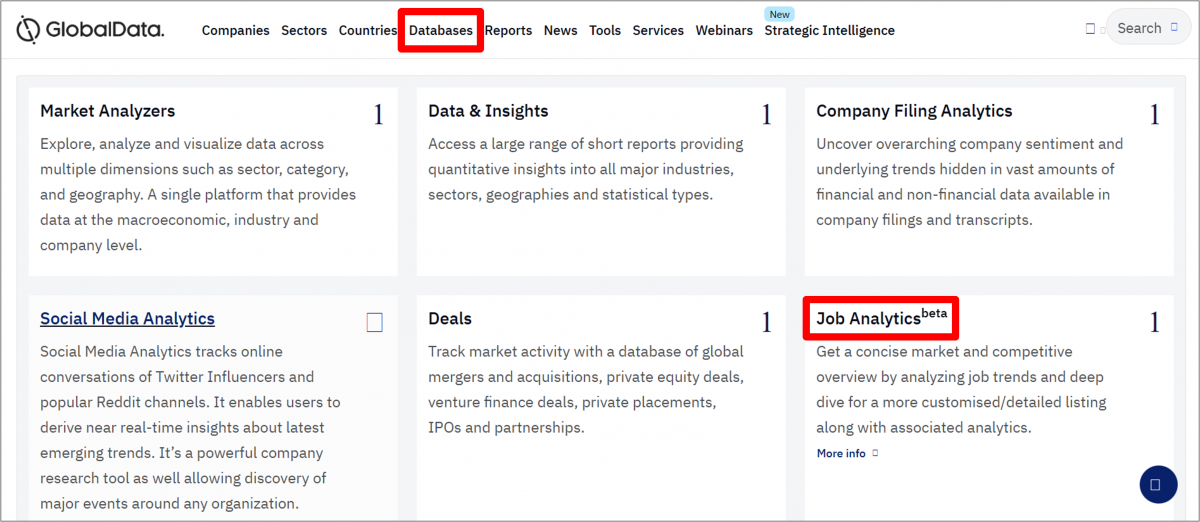
Job Analytics (JA) allows you to obtain a concise overview of the market and the competition by analysing employment trends, and then to delve deeper to obtain a more personalised and detailed list with related analyses.
JA covers more than 3.6 million jobs in over 18,000 million companies worldwide. This database has a global coverage of more than 200 countries by workplace: on the American continent, Europe, the Middle East and Africa, and Asia-Pacific. JA meticulously monitors the daily job offers published by organisations worldwide.
Hiring intentions serve as a significant indicator for identifying trends and critical signals across macroeconomic, sectoral, thematic and organisational dimensions. JA helps companies and universities understand the future of work, skills trends, qualifications and current job vacancies.

Let's look at a specific illustration of how Job Analytics can be used to search job market data for a Senior Engineering Manager position over the last 3 months in the US:
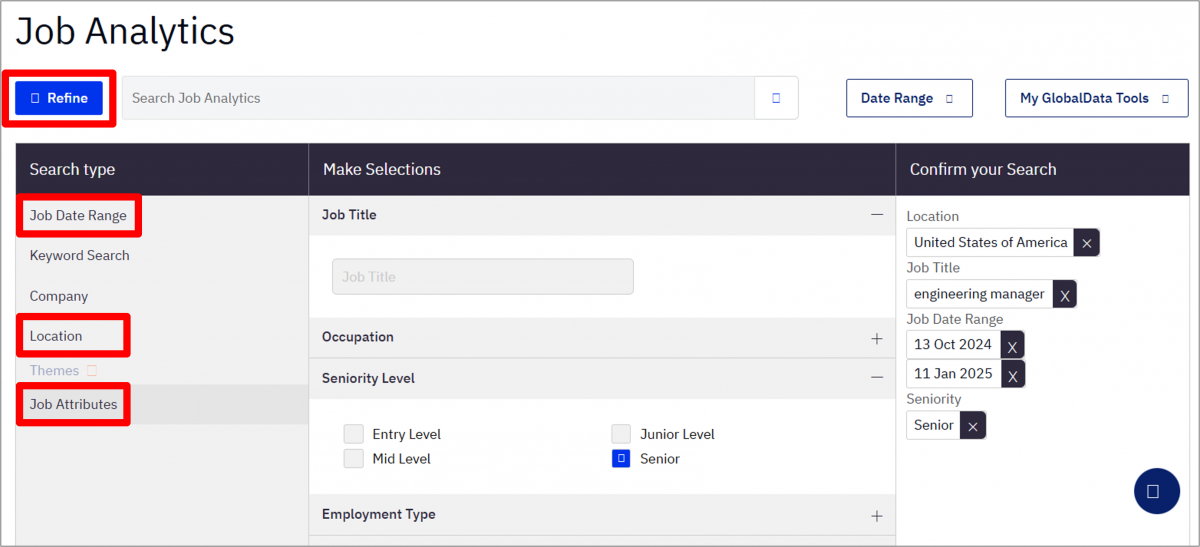
You will obtain results in the form of graphs or tables, which can be downloaded in various formats (pdf, image, cvs, json, etc.):
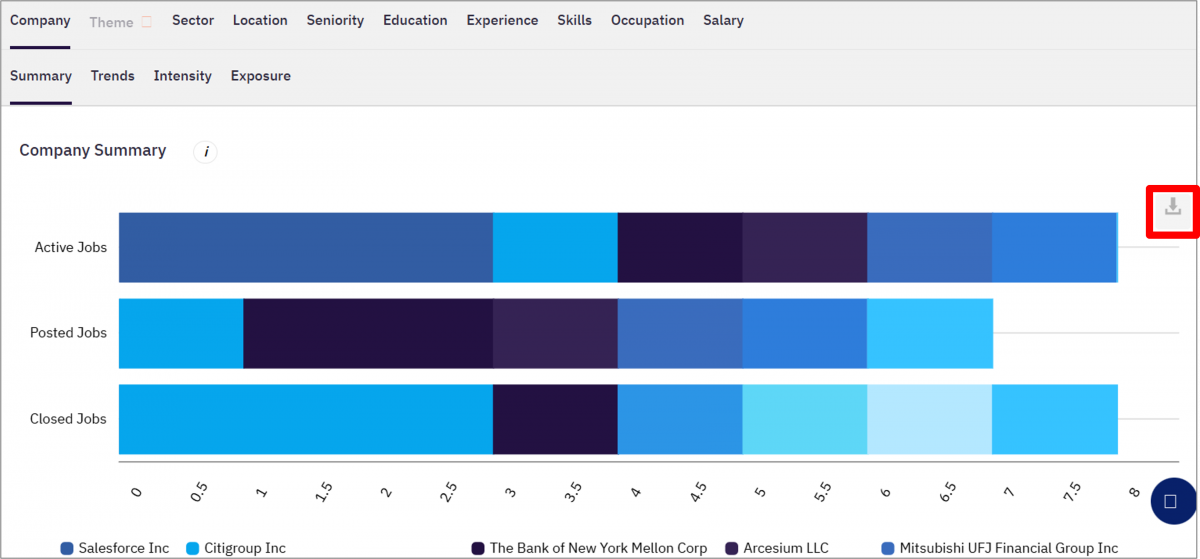
This database is very rich, and thanks to its granularity you can refine your searches and obtain very precise data.
GlobalData Explorer also allows you to find highly specialised data:
- country profiles, in the "Geography" database
- information about industry sectors, in the "Sector" database
- social media analyses, in the "Social Media" database
- job market data, in the "Job Analytics" database
Rate this content
How to find... - Tuesday 17 December 2024
Finding market shares with GlobalData Explorer

GlobalData Explorer (GDX) is a powerful set of databases containing information on markets, companies, countries and products. You can use it in two ways: either by typing keywords into the search bar on the home page to find different types of information on a subject, or by selecting a particular database to find a specific type of information. We will develop this second method below.
For market share research on an economic sector, on companies or on specific products, go to the ‘Databases’ tab in GlobalData Explorer :
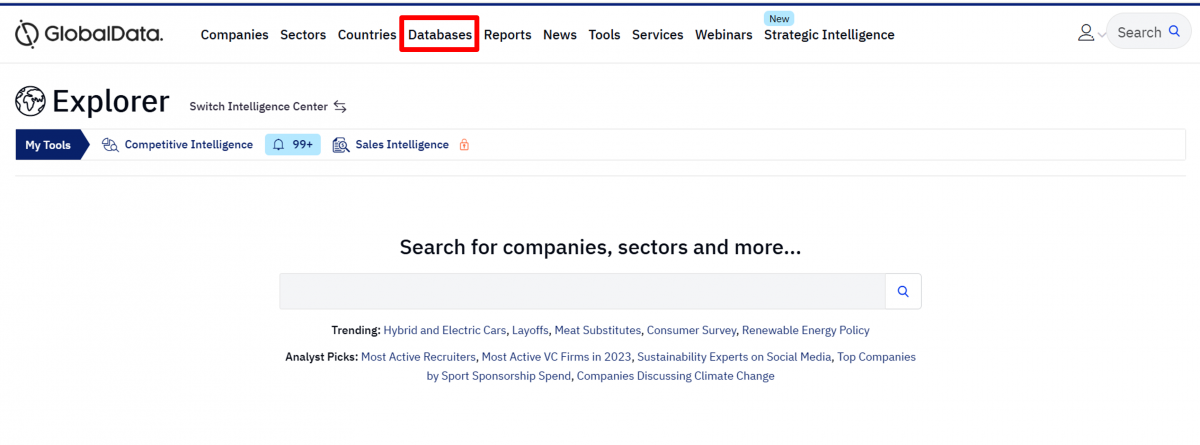
Among the resources accessible via ‘Databases’, Market Analyzers allows you to explore, analyse and visualise data across multiple criteria such as industry sector, category and geography.
It is a unique platform that provides data at macroeconomic, sectoral and company level.

Market shares can be determined on the basis of geographical location or specific criteria, with estimates provided in the form of monetary value or volume measures.
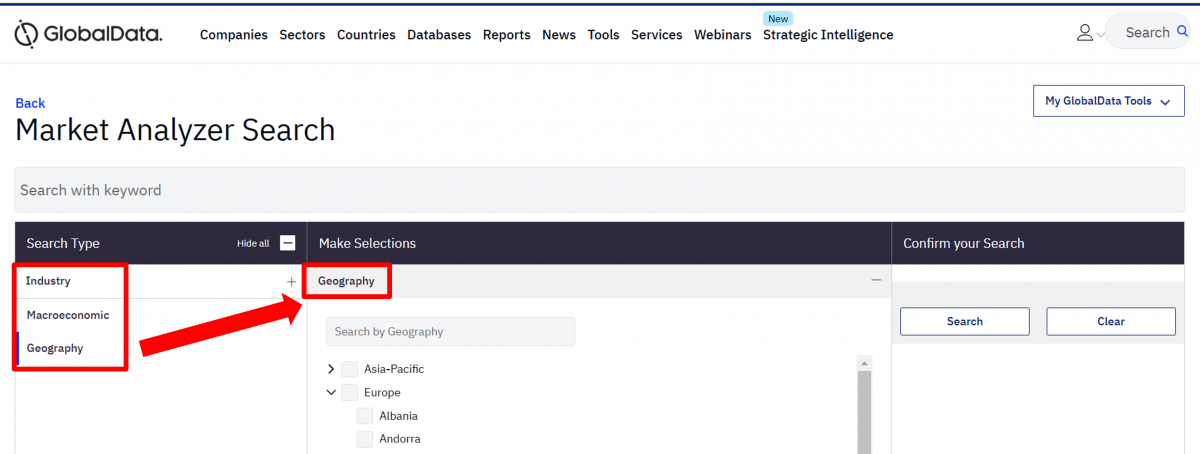
To illustrate the use of Market Analyzer, let's look at market shares in the agricultural sector, and more specifically for fruit and vegetables, comparing data between France and Italy.

This allows you to consult the forecast growth rates of these market shares for the coming years, while accessing various data relating to consumption patterns by demographic segment or analysing data relating to mass retailing.

We can see that the data is fine-tuned thanks to the filters applied in the previous steps. What's more, by clicking on the ‘graph’ button (screenshot above) you can obtain data in the form of graphs, which you can download in Excel, PDF or image format (screenshot below).
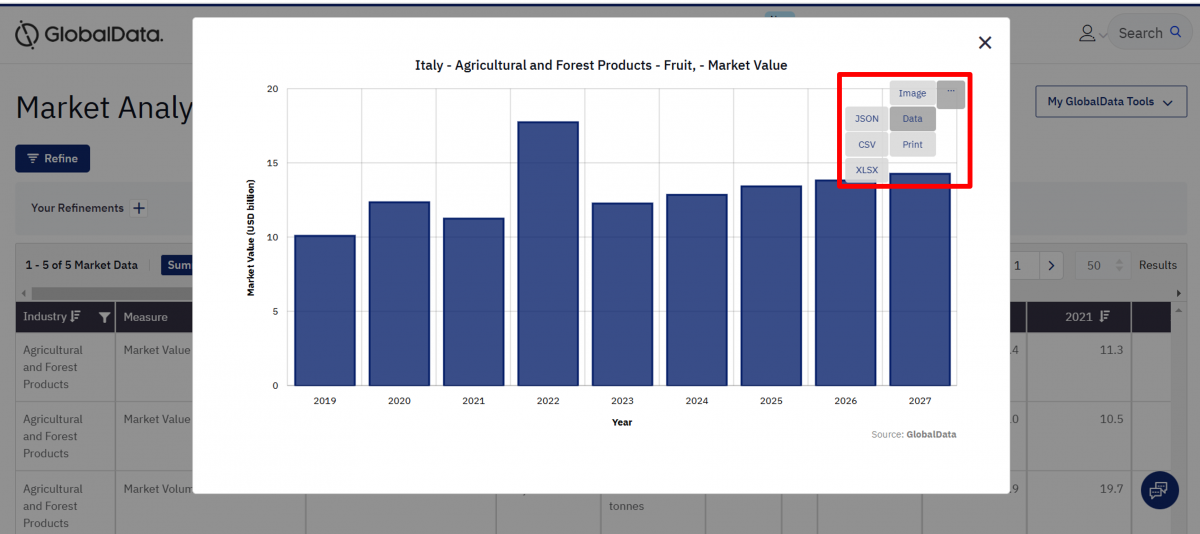
This database is very rich, and thanks to its granularity you can refine your searches and obtain very precise data.
GlobalData Explorer also allows you to find highly specialised data:
- country profiles, in the "Geography" database
- information about industry sectors, in the "Sector" database
- social media analyses, in the "Social Media" database
- job market data, in the "Job Analytics" database
For further information, you can also watch our video tutorial about how to access market studies on the Learning Center resources, on Moodle.
Rate this content
How to find... - Friday 25 February 2022
Find complementary market data

In our “how to find information about a business sector” highlight, we explained how to find full market reports on our databases. Unfortunately, not all market reports are available in full text in our subscriptions.
This concerns particularly the market reports form MarketResearch.com, but also some industry profiles, for example those of iCrowdNewswire. Though those resources aren’t so much cited in academic articles as other like Statista for example (more than 200 citations in CAIRN articles and books, versus only 1 for MarketResearch.com, 165 000 vs 36 000 in Google Scholar), the subjects they cover can be of interest for certain research.
There are ways to counter this lack of data, by using other complementary resources available at the Learning center.
For example, this study from MarketResearch.com about COVID impacts on businesses : “COVID-19 Outbreak-Global”. The study appears many times in Factiva results (more than 100) only because it is fragmented into small parts, one for each industry. An equivalent study can be found in GlobalData Explorer: "Coronavirus (COVID-19): Executive Briefing".
For some market studies about very specific industries, there won’t automatically be an equivalent in GlobalData Explorer or other databases for market studies. This one for example : “Automatic Soap Dispenser Market - Global Outlook & Forecast 2021-2026” from MarketResearch.com or this one : “Geothermal Power Market 2022, Industry Analysis, Size, Share, Growth, Trends and Forecast to 2028" from iCrowdNewswire. In that case, a useful recommendation could be to consult articles on the same topics and build one’s own market study this way. Open access sources on the web will also be of interest, like professional syndicates, consulting companies, etc.
20 results can be found on automatic soap dispensers in BSC :
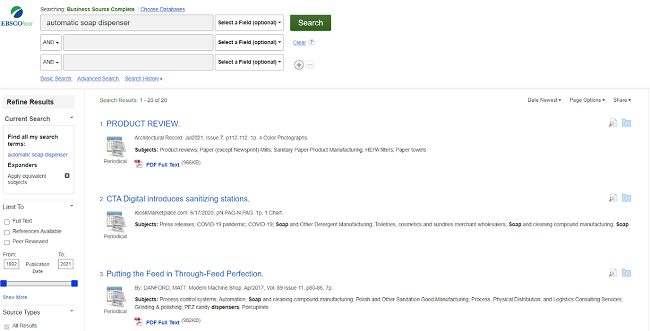
And thousands of results on geothermal power market in Google Scholar, of which the first ones are in full text and quite pertinent :
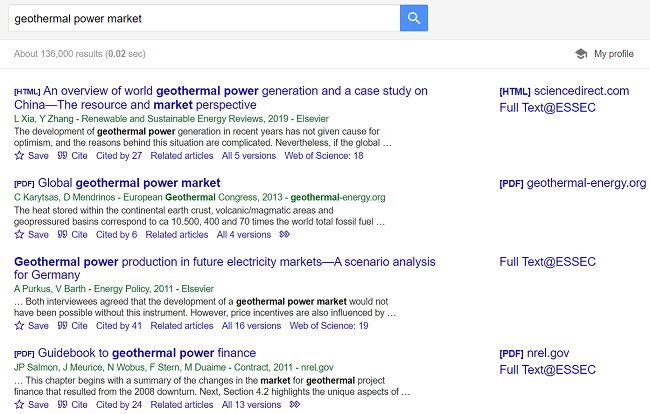
We could complement this presentation with, rather for french speakers, the following case study: there is a market study that is of great interest for one’s project in Xerfi, but the Learning Center doesn’t subscribe to that part of the database. What can learners do in that case ?
For example, this study on freelance platforms : "Les stratégies des plateformes de freelances, de jobbing et de crowdworking".
Books and articles from professionals or academics on this subject will help you identify important sources as they often refer to them in their endnotes.
First, a search on Discovery will point to books that could be a good synthesis on the subject :
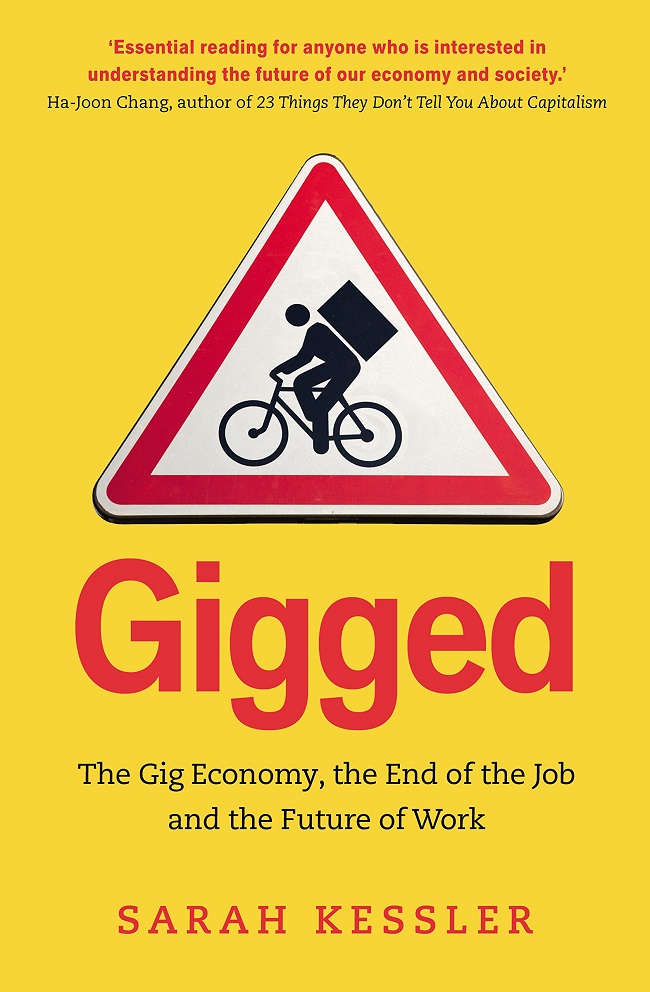
This book for example contains more qualitative analysis, but it will help you identify sources for quantitative data as it refers to a lot of sources in its endnotes.
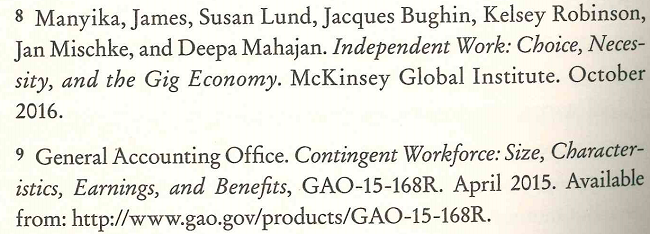
Extract from p.254. Notes
Discovery also enables learners to perform a first level search on academic and professional articles at the same time.
But this should be completed with specific searches on Factiva in english (applying the “and” operators between words) Europresse in french, and for academic or industry studies : CAIRN in french, Google Scholar in english.
And, as market data are the most valuable in this context, Statista will usefully complement your search :
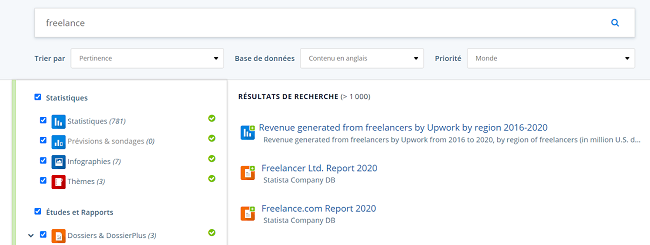
Any question? Contact the K-lab librarians, we are here to help!
Rate this content
How to find... - Friday 10 April 2020
Journal Search
Journal Search is a tool on Discovery that allows you to find any periodical the K-lab subscribes to.
The K-lab subscribes to many periodicals: general press, professional journals, academic journals... While a few titles are only accessible in paper version, the majority is now available online. Access can be different from one title to another, depending on the database they are available on.
To know where to find them, simply search for the title of the newspaper or journal in the "Journal Search" at the top of the page on Discovery.

By clicking on the result you are interested in, you will then be able to find out how to read the articles in the "View online" section. In this example, Le Monde is available on Business Source Complete (issues from 2006 to 2010 only) and on Europresse (all issues since 1944).

If you decide to use Business Source Complete, the link will take you directly to the page dedicated to Le Monde. You can then either click on "Search within this publication" to search for keywords, or use the list of publication dates on the right to access a specific issue.

If you choose to use Europresse, you will then be able to read the latest issue in the PDF area, or use the "advanced search" tool to search for older articles.
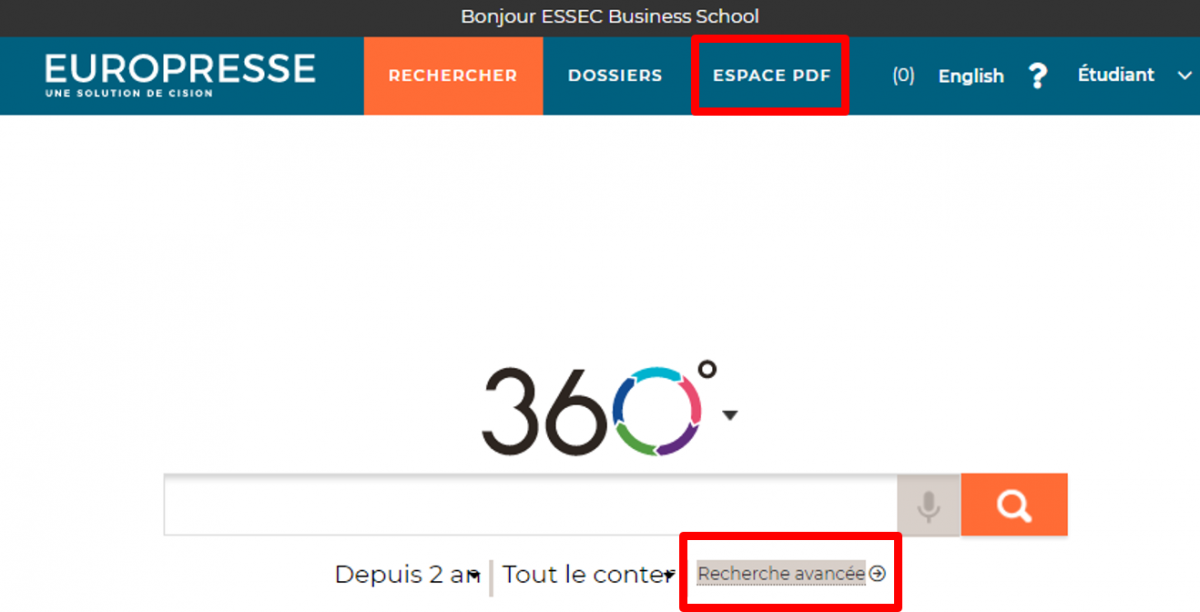
The links in the "View Online" section can refer to other databases, such as CAIRN or Factiva for example. Depending on the database, the link will sometimes take you directly to the journal in question, or you may need to use the search tool to access the articles.
The K-lab team is available to help you access the resources.
Rate this content
ENI makes a good resolution in 2020

The resource is diversifying by offering videos to complement the e-books. Always on learning in the field of computer science, management and DTP, ENI has added tutorial videos to its catalogue to improve the expectations of its users.
How you can find them:
First, log in to your MyEssec account, then access ENI via this link: ENI-training.com or the via the resource sheet ENI. You just need to enter a nickname each time you log in. On the home page, you can access your account on the top right. Use the search bar or the thematic headings to find the tutorial you want.
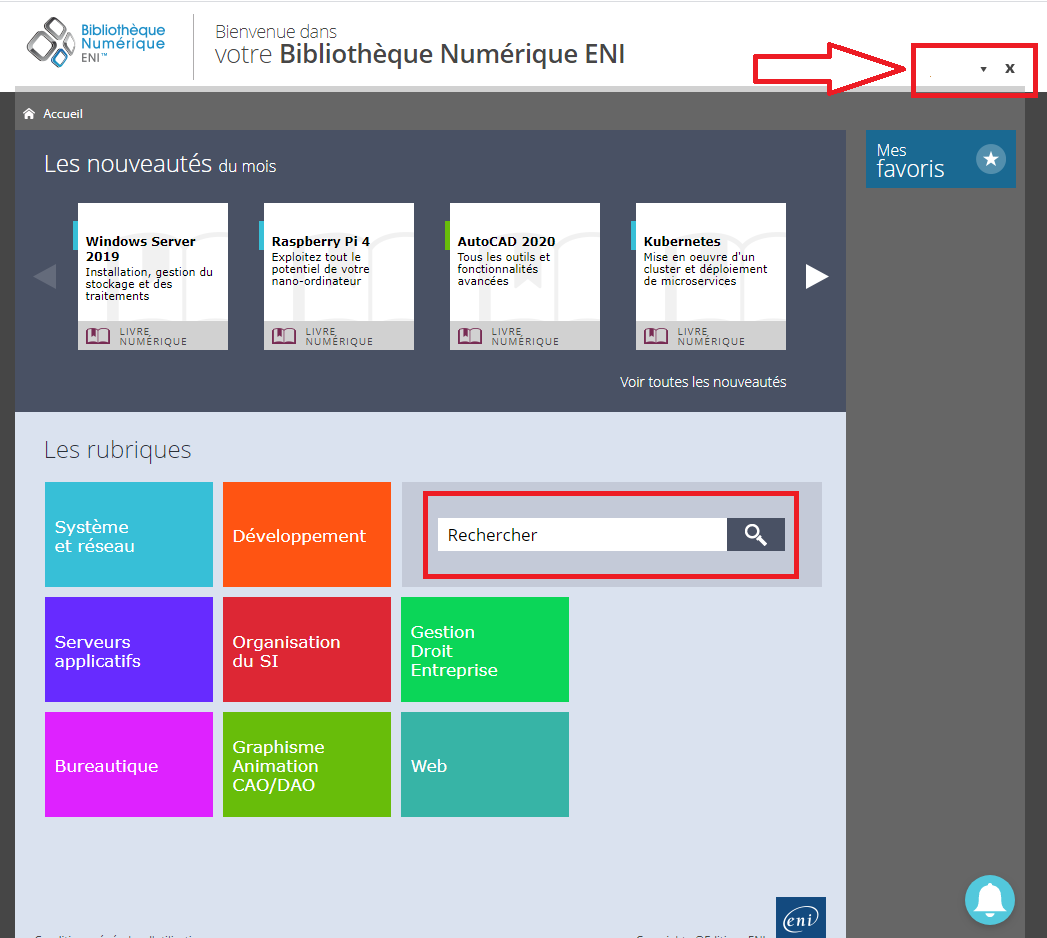
Then uncheck "livres" to access only the videos, in the filter, at the top left of your screen:
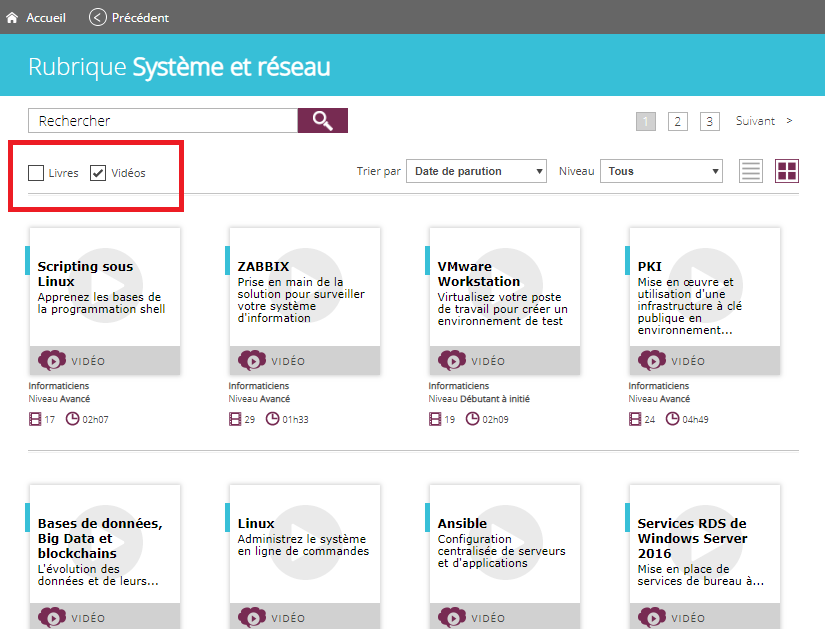
How to find... - Tuesday 06 November 2018
Royalty-free pictures and videos

This highlight will cover copyright as it is defined by French law. American Copyright (©) cannot be applied in France. It is very different from the French “droit d’auteur”, but it can be used to identify the entity that needs to be contacted to get the authorization to use copyrighted material.
Pictures
There are two types of rights you need to know and respect:
- the author’s copyright: the picture is protected if its originality is proved.
- the subject’s rights:
- if the persons can be recognized (ie if they are not part of a crowd), you need to make sure they have signed an authorization to use their image in the precise context you want to use it in.
- if the picture contains some type of creation (a building for example) that is protected by copyright : you need to make sure this creation can be reproduced. It can be reproduced if it is part of the public domain for example.
Any creation becomes part of the public domain 70 years after the death of its author. The picture can be used for free (no patrimonial rights) but the moral rights of the author must be respected, so you cannot modify it. There is no citation right for pictures: they must always be reproduced as a whole. (see: https://commons.wikimedia.org/wiki/Main_Page)
Videos
Audiovisual works are collaborative: they are created by multiple people who each have individual rights as well as rights over the video as a whole. To use a video, you need the authorization from all the co-authors. Rights are sold/transferred to the producer when a production contract is established.
Open licences
Open source or creative common licenses do not exist neither in French nor in Community law. However, they do have a contractual value, considering that the contracting party owns the piece’s rights. These licenses, created in 2002 by Lawrence Lessig, aim at making easier digital pieces dissemination thanks to a relaxing in the copyright. They start with the most open license (no attribution required, any use authorized) to the least open (attribution required, no derivatives and no commercial use) going through all the stages in between (commercial use authorized or not, derivatives accepted or not, attribution required or not).
Simon Villeneuve CC BY-SA
Resources
Websites listed below give access to images or videos under open license (restrictions might be applied as mentioned above) or in the public domain.
Videos for all purposes without authorization to ask or credit to give.
Pexels : photos and videos that can be searched by keywords.
Pixabay : a very large repository of photos and videos.
Videvo : more than 23 000 videos that can be searched by license type.
Pikwizard : has over 100,000 completely free images (CC0), with over 20,000 exclusive, and a lot of pictures of people.
Good practice
Always ask for an authorization if it is not clearly stated by the copyright holder for the use you consider doing: inside a school or a company, outside, for commercial or non commercial purpose.
When the permission has been given, the source must be cited to avoid plagiarism. Plagiarism is also a copyright infringement referred to as counterfeiting
Rate this content
New sources available in Europresse

Europresse gives access to thousands of generalist and specialized press sources. Each month, new titles are added to Europresse.
Among the latest ones, you can now access:
- Lawyer 2B, a English website providing pieces of advice, analyses, resources and news for students considering a career in law
- Légipresse, a French specialized review about media law and communication
- SPORT Stratégies, a French magazine specialized in sport marketing, media and communication
Many new references on a lot of different topics (lifestyle magazines, local press, company websites, etc) are available through Europresse.
How to find... - Friday 09 February 2018
Finding information about the luxury industry

Luxury is one of our fields of expertise at ESSEC. Some of the professors’ research is published on ESSEC Knowledge.
You will find here the main information sources available on the topic of luxury, from the web as well as from the Learning Center resources.
The Learning Center resources GlobalData Explorer, Xerfi Knowledge and Statista provide detailed, up-to-date market reports, both global and by country. You can also find some videos about the luxury market on Xerfi Canal, and other reports by Deloitte and IFOP:
You can borrow books about luxury at the Learning Center, at the shelfmark VI 498 or by using Discovery.
Articles about luxury can be found in marketing magazines, or in specific journals about fashion, cosmetics, or hospitality for example. Hence you can search other sources than luxury-centered ones. Indeed, you can search Business Source Complete et Google Scholar for academic journals (Journal of Marketing, Tourism and Hospitality Research, etc…), and Europresse for professional magazines (mainly in French): CosmetiqueMag, Points de Vente, L'Hôtellerie, Journal du Textile...
Some publications have a section dedicated to luxury (use the Learning Center resources to read the "subscribers-only" articles):
The Label Entreprise du Patrimoine Vivant was created by the French government to highlight the expertise of businesses.
A lot of websites specialize in luxury news:
- Journal du Luxe
- Luxe.net
- Jing Daily : the business of luxury in China
- Luxury Society
- Luxury Daily
- Luxuo
Here are some resources for information about fashion and Haute-Couture:
- Business of Fashion
- WWD
- Fashion Network
- Vogue
- Fédération de la haute couture et de la mode
- British fashion council
- “Qu'est-ce que la haute couture ?” Documentaire de Loïc Prigent (2016)
Lastly, have a look at the Twitter list “Luxury, Arts & Culture” curated by the ESSEC twitter account.



